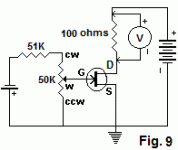The manual says to use 1/4 W RN55D resistors. Thing is that the RN55D only seem to come in 1/8 W. RN65D would be rated at 1/4W. Which ones should i use?
Thanks!
Thanks!
RN55D is 1/8W military spec. It is in real life 1/4W or even 400mW resistor. So you can use those. They are basically the same as CMF55, I always choose the cheapest ones at Mouser, sometimes the CMF55 sometimes the RN55
now the CMF55 seem to be rated at 1/2 watt - although i also saw a spec sheet rating them at 1/4 watt. i guess it's never a problem if a resistor can dissipate more W, right?
me learning a lot about resistors these days 🙂
on a different note i found a nice cap for C1. i was looking for a very small can with as much uF as possible as I'm trying to fit this in a rather small enclosure. i think for the size (25mm dia, 30mm height) this one with 12ooo uF is a good fit: Cornell Dubilier 381LX
me learning a lot about resistors these days 🙂
on a different note i found a nice cap for C1. i was looking for a very small can with as much uF as possible as I'm trying to fit this in a rather small enclosure. i think for the size (25mm dia, 30mm height) this one with 12ooo uF is a good fit: Cornell Dubilier 381LX
The CMF series are non-magnetic. I use them in most of my builds. The rated power dissapation of resistor will vary depending on the ambient temperature. The data sheet tells the whole story. Depending on the resistance, it is sometimes cheaper to buy the CMF series.
Hi 6L6, i got simple question. Has anyone build B1 with p channel jfets? I suppose one would just flip power supply and electrolytic caps, right?
considering how scarce they are , I hope you didn't ask for Toshina P JFets
🙂
yes , absolutely doable
🙂
yes , absolutely doable
no, I only got Linear Systems...
plus fake ones...I can experiment with those first, interestingly, when I measured curves, some fake ones overlapped with LSJ74
granted, they may not have low noise as Toshiba, but for fun, why not
plus fake ones...I can experiment with those first, interestingly, when I measured curves, some fake ones overlapped with LSJ74
granted, they may not have low noise as Toshiba, but for fun, why not
Ok, done. I made two B1 buffers, one with n-channel, one with p-channel, why not, you never know when you need buffers.
other reasons , to keep output impedance lowest possible
thanks for the tip in regards to lowering the resistors for low impedance. i installed some amtrans 39ohms and not sure if it made a difference but does allow me to try some low input impedance power amps now.
I have a question regarding the power on LED. The article says "D2 is a generic LED". I have a few LEDs with a rated forward voltage of 2.1V and forward current of 20 (30max) lying around. Would that work? .... or what else is considered a "generic" LED?
that is pretty much "generic LED"
say that rail voltage is 15V
for calculus , taking 2V for LED is precise enough
sat that we want 5mA through LED (prett bright in most cases)
so R=(Urail-Uled)/Iled
R= 13V/5mA = 2600R ........ first standard is 2K7
dissipation through resistor is P=I^2 x R = 5mA^2 x 2K7 =67.5mW , so regular small resistor is strong enough
say that rail voltage is 15V
for calculus , taking 2V for LED is precise enough
sat that we want 5mA through LED (prett bright in most cases)
so R=(Urail-Uled)/Iled
R= 13V/5mA = 2600R ........ first standard is 2K7
dissipation through resistor is P=I^2 x R = 5mA^2 x 2K7 =67.5mW , so regular small resistor is strong enough
thanks for the explanation! May i assume that R4 is the current limiting resistor for the LED? It's rated at 15k so according to your calculation that should allow 1mA through the LED, right?
1mA is pretty on spot what I'm always using ....... 5mA was just an example
more than 1mA , it will scream right in the eye
🙂
more than 1mA , it will scream right in the eye
🙂
thanks - i guess i'll just give it a shot and if it's not bright enough, drop the value of the resistor a bit. thanks for sharing your knowledge!
- Home
- Amplifiers
- Pass Labs
- B1 preamp build thread
